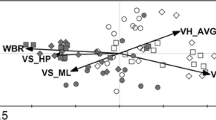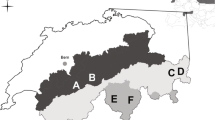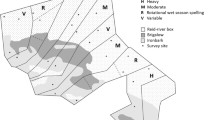Abstract
In patchy habitats, the relationship between animal abundance and cover of a preferred habitat may change with the availability of that habitat, resulting in a functional response in habitat use. Here, we investigate the relationship of two specialized herbivores, willow ptarmigan (Lagopus lagopus) and mountain hare (Lepus timidus), to willows (Salix spp.) in three regions of the shrub tundra zone—northern Norway, northern European Russia and western Siberia. Shrub tundra is a naturally patchy habitat where willow thickets represent a major structural element and are important for herbivores both as food and shelter. Habitat use was quantified using feces counts in a hierarchical spatial design and related to several measures of willow thicket configuration. We document a functional response in the use of willow thickets by ptarmigan, but not by hares. For hares, whose range extends into forested regions, occurrence increased overall with willow cover. The occurrence of willow ptarmigan showed a strong positive relationship to willow cover and a negative relationship to thicket fragmentation in the region with lowest willow cover at landscape scale, where willow growth may be limited by reindeer browsing. In regions with higher cover, in contrast, such relationships were not observed. Differences in predator communities among the regions may contribute to the observed pattern, enhancing the need for cover where willow thickets are scarce. Such region-specific relationships reflecting regional characteristics of the ecosystem highlight the importance of large-scale investigations to understand the relationships of habitat availability and use, which is a critical issue considering that habitat availability changes quickly with climate change and human impact.




Similar content being viewed by others
References
Andreev A (1988) The 10 year cycle of the willow grouse of lower Kolyma. Oecologia 76:261–267
Bates D, Maechler M, Dai B (2008) lme4: linear mixed-effects models using S4 classes [Computer software]. Available at: http://cran.r-project.org/
Chernov YI, Matveeva NV (1997) Arctic ecosystems in Russia. In: Wielgolaski FE (ed) Ecosystems of the World, vol 3, polar and alpine tundra. Elsevier, Oxford, pp 361–507
Den Herder M, Virtanen R, Roininen H (2004) Effects of reindeer browsing on tundra willow and its associated insect herbivores. J Appl Ecol 41:870–879
Den Herder M, Virtanen R, Roininen H (2008) Reindeer herbivory reduces willow growth and grouse forage in a forest-tundra ecotone. Basic Appl Ecol 9:324–331
Eigenbrod F, Hecnar SJ, Fahrig L (2010) Sub-optimal design has major impacts on landscape-scale inference. Biol Conserv. doi:10.1016/j.biocon.2010.09.007
Elson LT, Schwab FE, Simon NPP (2007) Winter food habits of Lagopus lagopus (Willow ptarmigan) as a mechanism to explain winter sexual segregation. Northeastern Nat 14:89–98
Estaf’ev AA, Mineev YN (1984) Seasonal distribution of willow ptarmigan in tundra of European north-east of USSR. In: Animals—components of the ecosystem of the European North and Ural. University of Syktyvkar, Russia (in Russian)
Evans SA, Mougeot F, Redpath SM, Leckie F (2007) Alternative methods for estimating density in an upland game bird: the red grouse Lagopus lagopus scotieus. Wildl Biol 13:130–139
Feinsinger P (1994) Habitat “shredding”. In: Meffe GK, Carroll CR (eds) Principles of conservation biology. Sinauer Associates, Sunderland, pp 258–260
Forbes BC, Stammler F, Kumpula T, Meschtyb N, Pajunen A, Kaarlejarvi E (2009) High resilience in the Yamal-Nenets social-ecological system, West Siberian Arctic, Russia. Proc Natl Acad Sci USA 106:22041–22048
Fortin D, Courtois R, Etcheverry P, Dussault C, Gingras A (2008) Winter selection of landscapes by woodland caribou: behavioural response to geographical gradients in habitat attributes. J Appl Ecol 45:1392–1400
Fretwell SD (1972) Populations in a seasonal environment. Princeton University Press, Princeton
Gelman A, Hill J (2007) Data analysis using regression and multilevel/hierarchical models. Cambridge University Press, Cambridge
Hakkarainen H, Virtanen R, Honkanen JO, Roininen H (2007) Willow bud and shoot foraging by ptarmigan in relation to snow level in NW Finnish Lapland. Polar Biol 30:619–624
Henden JA, Ims RA, Yoccoz NG, Sørensen R, Killengreen ST (2010) Population dynamics of tundra voles in relation to configuration of willow thickets in southern arctic tundra. Polar Biol. doi:10.1007/s00300-010-0908-7
Henden J-A, Ims RA, Yoccoz NG, Killengreen ST (2011) Declining Willow ptarmigan populations: The role of habitat structure and community dynamics. Basic Appl Ecol (in press)
Ims RA, Yoccoz NG, Brathen KA, Fauchald P, Tveraa T, Hausner V (2007) Can reindeer overabundance cause a trophic cascade? Ecosystems 10:607–622
Johnsen TV, Systad GH, Jacobsen KO, Nygard T, Bustnes JO (2007) The occurrence of reindeer calves in the diet of nesting Golden Eagles in Finnmark, northern Norway. Ornis Fenn 84:112–118
Johnson DH (1980) The comparison of usage and availability measurements for evaluating resource preference. Ecology 61:65–71
Killengreen ST (2010) Sources of spatial variation in food web structure in low Arctic tundra. PhD dissertation, University of Tromsø, Tromsø
Killengreen ST, Ims RA, Yoccoz NG, Brathen KA, Henden JA, Schott T (2007) Structural characteristics of a low Arctic tundra ecosystem and the retreat of the Arctic fox. Biol Conserv 135:459–472
Kitti H, Forbes BC, Oksanen J (2009) Long- and short-term effects of reindeer grazing on tundra wetland vegetation. Polar Biol 32:253–261
Kolosov AM, Lavrov NP, Naumov SP (1965) Mountain hare—Lepus timidus L. In: Biology of hunted animals of the USSR. Vyshaya Shkola, Moskva, pp 328–335 (in Russian)
Krebs CJ, Boonstra R, Nams V, O’Donoghue M, Hodges KE, Boutin S (2001) Estimating snowshoe hare population density from pellet plots: a further evaluation. Can J Zool 79:1–4
Labutin YV (1988) Particularities of the spatial distribution and behaviour of mountain hares (Lepus timidus) in Yakutia as adaptations of the species to northern conditions. Russ J Ecol 2:40–44 (in Russian)
Lima SL, Dill LM (1990) Behavioral decisions made under the risk of predation—a review and prospectus. Can J Zool 68:619–640
Mayor SJ, Schneider DC, Schaefer JA, Mahoney SP (2009) Habitat selection at multiple scales. Ecoscience 16:238–247
McGarigal K, Cushman SA, Neel MC, Ene E (2002) FRAGSTATS: Spatial Pattern Analysis Program for Categorical Maps. Computer software program produced by the authors at the University of Massachusetts, Amherst, USA
Moen A (1998) Nasjonalatlas for Norge. Vegetasjon. Statens kartverk, Hønefoss
Mysterud A, Ims RA (1998) Functional responses in habitat use: availability influences relative use in trade-off situations. Ecology 79:1435–1441
Mysterud A, Larsen PK, Ims RA, Ostbye E (1999) Habitat selection by roe deer and sheep: does habitat ranking reflect resource availability? Can J Zool 77:776–783
Newey S, Willebrand T, Haydon DT, Dahl F, Aebischer NJ, Smith AA, Thirgood SJ (2007) Do mountain hare populations cycle? Oikos 116:1547–1557
Nystrom J, Ekenstedt J, Engstrom J, Angerbjorn A (2005) Gyr Falcons, ptarmigan and microtine rodents in northern Sweden. Ibis 147:587–597
Nystrom J, Ekenstedt J, Angerbjorn A, Thulin L, Hellstrom P, Dalen L (2006) Golden Eagles on the Swedish mountain tundra—diet and breeding success in relation to prey fluctuations. Ornis Fenn 83:145–152
Orians GH, Wittenberger JF (1991) Spatial and temporal scales in habitat selection. Am Nat 137:29–49
Pajunen AM (2009) Environmental and biotic determinants of growth and height of arctic willow shrubs along a latitudinal gradient. Arct Antarct Alp Res 41:478–485
Pajunen AM, Kaarlejarvi EM, Forbes BC, Virtanen R (2010) Compositional differentiation, vegetation–environment relationships and classification of willow-characterised vegetation in the western Eurasian Arctic. J Veg Sci 21:107–119
Pavlinin VV (1997) Particularities of the ecology of mountain hare (Lepus timidus) on Yamal. In: Materialy po istorii i sovremennomu sostoyaniyu fauni severa Zapadnoy Sibiri, pp 31–42 (in Russian)
Post E, Pedersen C (2008) Opposing plant community responses to warming with and without herbivores. Proc Natl Acad Sci USA 105:12353–12358
R Development Core Team (2010) R: a language and environment for statistical computing. R Foundation for Statistical Computing, Vienna
Ravolainen VT, Yoccoz NG, Brathen KA, Ims RA, Iversen M, Gonzalez VT (2010) Additive partitioning of diversity reveals no scale-dependent impacts of large ungulates on the structure of tundra plant communities. Ecosystems 13:157–170
Ripple WJ, Beschta RL (2005) Refugia from browsing as reference sites for restoration planning. West North Am Nat 65:269–273
Shtro VG (2006) Notes about the behaviour of mountain hares in the tundra of Yamal. Nauchniy Vestnik YNAO 1(38):173–174 (in Russian)
Skogstad G (2009) Does habitat fragmentation of willow thickets have spill-over effects on tundra vegetation? Master Thesis, University of Tromsø, Tromsø
Smith AC, Koper N, Francis CM, Fahrig L (2009) Confronting collinearity: comparing methods for disentangling the effects of habitat loss and fragmentation. Landsc Ecol 24:1271–1285
Storch I (2007) Grouse. Status and Conservation Action Plan 2006–2010. IUCN Species Survival Commission
Sturm M, Racine C, Tape K (2001) Climate change—increasing shrub abundance in the Arctic. Nature 411:546–547
Tape K, Sturm M, Racine C (2006) The evidence for shrub expansion in Northern Alaska and the Pan-Arctic. Glob Change Biol 12:686–702
Tape KD, Lord R, Marshall HP, Ruess RW (2010) Snow-mediated ptarmigan browsing and shrub expansion in arctic Alaska. Ecoscience 17:186–193
Virtanen R, Oksanen L, Razzhivin VY (1999) Topographical and regional patterns of tundra heath vegetation from northern Fennoscandia to the Taimyr peninsula. Acta Bot Fenn 167:29–83
Walker DA, Raynolds MK, Daniels FJA, Einarsson E, Elvebakk A, Gould WA, Katenin AE, Kholod SS, Markon CJ, Melnikov ES, Moskalenko NG, Talbot SS, Yurtsev BA (2005) The Circumpolar Arctic vegetation map. J Veg Sci 16:267–282
Watson A, Moss R (2004) Impacts of ski-development on ptarmigan (Lagopus mutus) at Cairn Gorm, Scotland. Biol Conserv 116:267–275
Weeden RB (1969) Foods of rock and willow ptarmigan in central Alaska with comments on interspecific competition. Auk 86:271–281
West GC, Meng MS (1966) Nutrition of willow ptarmigan in northern Alaska. Auk 83:603–615
Williams JB, Best D, Warford C (1980) Foraging ecology of ptarmigan at Meade River, Alaska. Wilson Bull 92:341–351
Wookey PA et al (2009) Ecosystem feedbacks and cascade processes: understanding their role in the responses of Arctic and alpine ecosystems to environmental change. Glob Change Biol 15:1153–1172
Acknowledgments
We are grateful to Eeva Soininen, Ingrid Jensvoll, Anna Rodnikova, Victor Sidorov, Olga Kulikova and many others for great contributions to the field work, and we thank two anonymous reviewers for their comments on a previous version of the paper. This study was financed by the Research Council of Norway through the projects “EcoFinn” and “IPY-Arctic Predators” (http://www.arctic-predators.uit.no).
Author information
Authors and Affiliations
Corresponding author
Additional information
Communicated by Janne Sundell.
Electronic supplementary material
Below is the link to the electronic supplementary material.
Rights and permissions
About this article
Cite this article
Ehrich, D., Henden, JA., Ims, R.A. et al. The importance of willow thickets for ptarmigan and hares in shrub tundra: the more the better?. Oecologia 168, 141–151 (2012). https://doi.org/10.1007/s00442-011-2059-0
Received:
Accepted:
Published:
Issue Date:
DOI: https://doi.org/10.1007/s00442-011-2059-0




